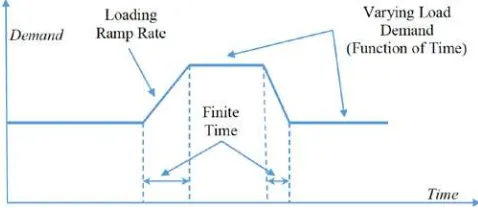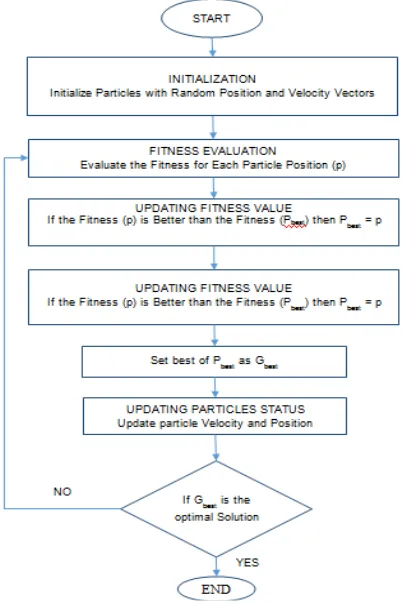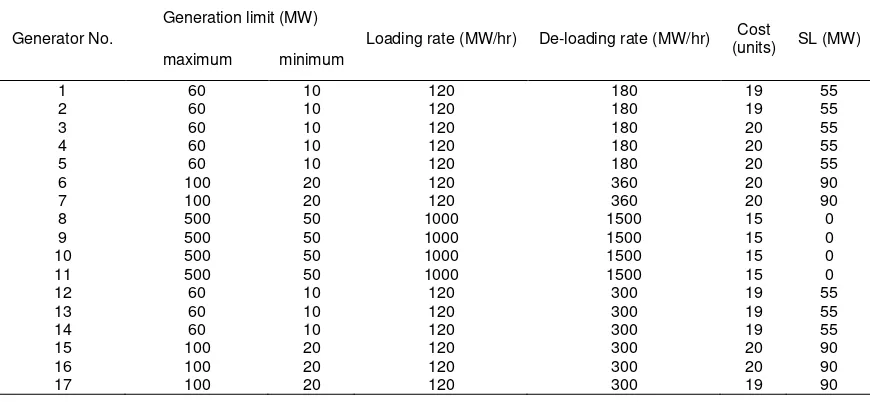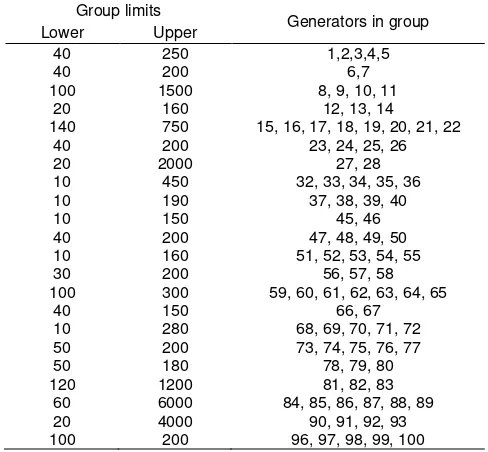DOI: 10.12928/TELKOMNIKA.v14i3.4054 1042
Particle Swarm Optimization Performance: Comparison
of Dynamic Economic Dispatch with Dantzig-Wolfe
Decomposition
Mohd Ruddin Ab Ghani*1, Saif Tahseen Hussein2, Zanariah Jano3, Tole Sutikno4
1,2Faculty of Electrical Engineering, Universiti Teknikal Malaysia Melaka (UTeM),
76100, Durian Tunggal, Melaka, Malaysia
2 Ministry of Electricity, Baghdad, Iraq 3
Centre for Languages and Human Development, Universiti Teknikal Malaysia Melaka (UTeM)
4Department of Electrical Engineering, Faculty of Industrial Technology, Universitas Ahmad Dahlan (UAD),
Jln Prof. Dr. Soepomo, Janturan, Yogyakarta 55164, Indonesia *Corresponding author, email: [email protected]
Abstract
Economic Dispatch (ED) problem, in practice, is a nonlinear, non-convex type,whish has developed gradually into a serious task management goal in the planning phase of the power system. The prime purpose of Dynamic Economic Dispatch (DED) is to minimize generators’ total cost of the power system. DED is to engage the committed generating units at a minimum cost to meet the load demand while fulfilling various constraints. Utilizing heuristic, population-based, and advanced optimization technique, Particle Swarm Optimization (PSO), represents a challenging problem with large dimension in providing a superior solution for DED optimization problem. The feasibility of the PSO method has been demonstrated technically, and economically for two different systems, and it is compared with the Dantzig-Wolfe technique regarding the solution quality and simplicity of implementation. While Dantzig-Dantzig-Wolfe method has its intrinsic drawbacks and positive features, PSO algorithm is the finest and the most appropriate solution. Conventional techniques have been unsuccessful to present compatible solutions to such problems due to their susceptibility to first estimates and possible entrapment into local optima which may complicate computations.
Keywords: particle swarm optimization (PSO), Dantzig-Wolfe decomposition, problem formulation, dynamic economic dispatch (DED)
Copyright © 2016 Universitas Ahmad Dahlan. All rights reserved.
1. Introduction
Dynamic economic dispatch (DED) problem is one of the essential operational matters in power system. The main objective of employing optimization technique is to minimize the total operation costs of the generation units while fullfilling all required constraints. Several traditional methods are used to solve this problem like Lagrangian and gradient methods [1-2]. Solving DED problem using these classical methods essentially assumes a monotonic increase in the curves representing the incremental cost of generators with a function characterized by a piecewise linearization. However, in practical system, the nonlinear characteristics of these generation units may not comply with such linearization assumption and resulting in an infeasibilty status [3]. Large-scale power system involving large number of generating units with contradicting constraints and possible non-smooth cost function requires longer solution time. In Addition, various constraints may play a causative role in increasing the dimension of the DED problem. Therefore, requiring large computational resources, excessive numerical iterations, and enourmous calculation efforts [4]. To make more convenient formulation to the numerical methods for solving the DED problem optimally, Dantzig-Wolfe DW is used to solve DED problems for units with quadratic functions for the fuel cost and considering various equality and inequality constraints. Although the DW method have been utilized to find solution for complex DED optimization problems, some problems have been identified in DW due to complicated problem formulation [1-2].
cost while satisfying equality and inequality constraints [5-6]. DED problems are non-linear, complicated, dynamic optimization problem. Many methods have been developed to find optimum solution for the dynamic economic dispatch problem, such as linear programming [7], Lagrange relaxation method [8], dynamic programming [9]. Nevertheless, the discontinuity and nonlinearity of the search domain, to obtain the optimal solution lead to sub-optimal solution due to the entrapping in a local optimum [7].
Kennedy and Eberhart [11] introduce Particle swarm optimization (PSO) as a modern heuristic technique which mimics the behavior of birds flock or fish school. The PSO algorithm can lead to a higher quality solution with time and secure convergence in comparison with other stochastic methods. DED is solving the economic dispatch in every time increment power variation.
In the recent years, new meta-heuristic optimization approaches and methods are being significantly utilized as an alternative to the traditional methods to address the DED problem regarding quality, speed, and efficiency, due to their favorable search characteristics as population-based. PSO technique was adopted to address nonlinearity and complexity issues of the optimization problem [10-16].
PSO has been characterised with several advantages of crucial importance over current optimization methods on their speed of convergence, robustness, and distinctive simplicity [12]. Because the established process of PSO involves two basic updating rules only, to implement in computer simulations using basic logic and mathematical operations is easy. Furthermore, PSO can be compliant when hybridized with other optimization techniques because it has a fewer number of operators to conform to other techniques in the implementation process [12-13].
PSO shows that the particles’ motion is regulated by its previous velocity, besides two other elements of acceleration, namely cognitive component and social component. Cognitive and social components depend on the acceleration coefficients and the uniformly distributed random numbers associated with PSO variants. The behavior of the particles is highly dependent on the relative values of these components. In case the cognitive component has a higher value compared to the social component, it will result in aimlessly unrestrained motion of a particle through search space. On the contrary, particles may results in an untimely advance towards local optima and assume it as the required solution when the social element has a relatively high value, in other words, it is more susceptible to be entrapped into local optima.
Exploring search space and exploiting local domain highly rely on the values of the particles velocity where every dimension’s particles velocity is ensured to have a maximum velocity ����. If this maximum velocity assumes high value initiates global exploration, conversely, low value motivates local exploitation. For this reason, Shi and Eberhart [17] propose the inertia weight concept to efficiently manipulate exploration and exploitation and attaining enhanced quality of the optimal solution and minimizing convergence time.
Unlike alternative and similar modern optimization techniques like genetic algorithms which have exorbitant evolutional operations regarding computational resources such as mutation and crossover, PSO facilitates a better performance and expedite convergence [10]. The mechanism of PSO makes it a derivative-free algorithm unlike the classical optimization techniques and this feature especially makes it suitably effective in handling nonlinearity and complex problems. PSO shows more robustness to deal with such problems because it is less susceptible to the objective function nature regarding continuity and convexity [14] to the optimizer parameters [9]. Inherently, the inner working mechanism of PSO assists in breaking free from local optima.
In this paper, the particle swarm optimization (PSO) algorithm was proposed to deal with the DED problem considering various equality and inequality constraints. Compared with the Dantzig-Wolfe decomposition technique. The performance of the proposed optimization method was tested on a real data system with 20 and 100 generation units as a test system.
2. Problem Formulation
problem. The objective function to be optimized (minimized in this case) is the Total generation cost:
��� ∑��=1��( ��) (1)
In practice, usually, Fi (Pi) is expressed in form of a quadratic function as follows:
��(��) = ��+ ����+ ����2 (2)
Where, ai, bi and ci represent the cost coefficients of the generator, N is the number of
generators, Pi is the power produced by the ith generator (MW), Fi (Pi) is the operating cost of
the generation unit i ( $/h). The optimization is subject to the following constraints.
2.1. Equality Constraints
The power balance which is defined as the equality constraints, where the total generated power must meet the total power demand requirement and the power loss which may include the spinning reserve, formulated as in the following equation:
∑��=1��− � − ��= 0 (3)
2.2. Inequality Constraints
Taking the operational limits on physical devices to ensure safe and stable production of power in addition to guarantee system security dictates the consideration of another set of constraints referred to as the inequality constraints, which are represented by the following formula:
����� ≤ �� ≤ ����� ����= 1, 2, 3 … . .��
��= ∑��=1∑��=1������� + ∑��=1�0� ��+ �00 (4)
Ramp rate limit, or the loading and deloading rate limits of the generator are defined based on practical aspects and operational considerations of the generators such as mechanical stresses and load, Figure 1. Therefore, the capacity of generating units requires a finite time to change the capacity of a specified thermal plant.
Figure 1. Typical load profile unit variations with time
2.3. Additional Constraints
��=����� ��� �� ���≤ �
�≤ ���
�����− �� ��� ���≤ ��≤ ������
Another type of constraint, referred as the group constraint, wherein different generators combined output is limited by certain boundaries. The causes may include regulatory restrictions, limitations in transmission line conducting capacity, and area security considerations.
3. Particle Swarm Optimization with Dantzig-Wolfe Method
Particle swarm optimization (PSO) is a population-based continuous optimization technique and one of the gradually developed modern optimization method, proposed by Kennedy and Eberhart (1995). A population of random solutions is used to initialize the system for iterative searches for optima by continuously updating the generation levels [13]. PSO is Characterized by advantageous features, unlike other similar evolutionary technique like the Genetic Algorithm GA with no costly evolutionary operators like mutant and crossover which makes PSO suitable for providing better performance and expediting convergence. The particles in the PSO represent the potential solutions; these particles change their positions through the search space by traveling towards the present particles.
Figure 2. Particle Swarm Optimization Generic Flowchart
Particle Swarm Optimization can be utilized to address several problems associated with other similar modern algorithms. PSO features group interaction which provides a pool of shared information which acts as a memory that facilitates to progress toward the optimal solution. Within the set of the population, each particle keeps track of ‘memorizing’ the best solution referred to as the Pbest, which is associated with its coordinates in the hyperspace.
is reached through the tracking of the overall best value, which is called Gbest. The concept of PSO involves varying the velocity of each particle toward its Pbest and Gbest at each step as
illustrated in, Figure 2. Acceleration toward Pbest and Gbest is being weighted according to a
random term [14, 15]. In the beginning, the research is aiming at model the social behavior of bird flocks, fish schools, and animal herds graphically. Nevertheless, the original version is capable of addressing nonlinear continuous optimization problems only. Further developments in this PSO algorithm have enabled the search for global optimal solutions of complex engineering and sciences problems.
Comparing particle swarm optimization PSO with Dantzig-Wolfe D-W regarding the following points:
1. Implementation: D-W method is difficult and cumbersome. Constructing the block diagonal structure for decomposition requires an enormous manual work, observation and decision. On the other hand, the PSO can be more easily implemented both for constraints and objective function to be optimized.
2. Addition or removal of constraints can be achieved easily with PSO, while in the D-W, this process needs to be analyzed from the beginning.
3. The D-W method takes less time to find the solution in comparison with PSO method. However, this problem can be greatly alleviated by adopting hybridization to reach the required optimal solution.
Code debugging of unintentional errors in the implemented block diagonal structure of the D-W method is tiresome and susceptible to further mistakes while PSO code can be debugged easily.
4. Optimization Results and Discussions
The performance of the developed algorithm of particle swarm optimization PSO is tested using real data of power system in two case studies; with a primary target of minimizing the cost function for both case studies. The first case study involves twenty generation units with twenty-four periods, for this problem, the equality constraints, inequality constraints, ramp rate limits, spinning reserve, and bound generation limits have been defined for each generation units. The optimizer has to find an optimum solution to a problem with 480 variables which is considered a high dimensionality problem.
The second case study involves one hundred generation units with five periods with a similar type of constraints as in the first case study in addition to the group constrained which is associated with this problem of 500 variables, which means another high-dimensionality problem.
The simulation results cover two cases; an optimal case which involves minimizing the cost function subject to the constraints of total periods taken into consideration at the same time. While, the sub-optimal case involves finding the solution period by period subject to the constraints, thus reaching a sub-optimal solution, but in sub-optimal case the required computational resources are far less than in the optimal case. The input data for both cases are given in the Appendix A.
4.1. Case Study 1
Table 1. Simulation results of 20-generator with 24 periods system Comparison between the Dantzig-Wolfe and PSO methods for DED
No. Generators / periods Case Cost (Unit Cost)
PSO D-W
1
20/ 6 Optimal 27000.78 27028.43
2 Sub-Optimal 27033.60 27031.22
3 20/12 Optimal 52207.89 52652.89
4 Sub-Optimal 52210.53 52653.22
5
20/18 Optimal 76416.21 76982.39
6 Sub-Optimal 76455.49 77000.74
7
20/24 Optimal 98836.58 99545.54
8 Sub-Optimal 98843.06 99595.35
D-W: Dantzig-Wolfe decomposition method PSO: Particle Swarm Optimization method Optimal: Solution over the entire periods Sub-Optimal: Solution period-by-period
4.2. Case Study 2
The second case study examined the performance of the PSO algorithm for the 100 generators with five periods. This result is an optimization problem with a dimension of 600 (100x6, including the initial conditions) variables to be evaluated and optimized accordingly. In addition to the ramp rate constraints, this problem had spinning reserve constraints and group constraints. The 600 variables problem was solved using the PSO method. The total cost was minimized to 659395.10 units as the optimal solution compared to 663017.40 units using Dantzig-Wolfe method. As for the sub-optimal solution where the problem was solved period by period, the total cost was found to be 659430 units compared 663099 units using Dantzig-Wolfe method.
Table 2 summarizes the findings for this case of 100 generators with five periods (with 22 group import-export constraints) and shows the results of Dantzig-Wolfe simulation results for both optimal and sub-optimal [1-2]. For both case studies, the particle swarm optimization PSO outperforms the Dantzig-Wolfe D-W method in finding the minimum cost by solving the optimization problem subject to similar constraints for both approaches. In addition to the advantages and beneficial features that characterize PSO over the classical technique D-W as explained in this paper, the achieved solution for both situation optimal and sub-optimal results in a better cost value when solved by PSO compared to D-W method.
Table 2. Simulation results of 100-generator with five periods system
Comparison between the two methods for 100-generator system (with 22-group import-export constraints)
No. Generators / periods Case Cost (Unit Cost)
PSO D-W
1
100/5 Optimal 659395.10 663017.40
2 Sub-Optimal 659430.00 663099.00
5. Conclusion
been demonstrated to perform well compared to the D-W algorithm on real data network problems, and it appears to attain a better minimum cost value. The effectiveness of the developed PSO program is tested for twenty generators with 24 periods and 100 generators with 5 periods experimental data. The results obtained by these methods are compared with each other. It is found that PSO optimization algorithm is giving better results than D-W decomposition optimization techniques.
Acknowledgements
The authors gratefully acknowledge the funding provided by the Ministry of Electricity of Iraq (MOE) and their continuous support and encouragement. The authors also would like to gratefully acknowledge the funding support provided by the Ministry of Higher Education Malaysia under the research grant No: FRGS/2/2013/ TK02/FKE/01/F00167.
References
[1] Ab Ghani MR. Optimised Unit Commitment and Dynamic Economic Dispatch for Large Scale Power Systems. PhD. Thesis. United Kingdom: The University of Manchester Institute of Science and Technology (UMIST); 1989.
[2] Hindi KS, Ab Ghani MR. Multiperiod Secure Economic Dispatch for Large Scale Power System.
Generation, Transmission and Distribution, IEE Proceedings. 1989; 136(3): 130-136.
[3] Orike S, Corne DW. A Memetic Algorithm for Dynamic Economic Load Dispatch Optimization. Proc. 2013 IEEE Symposium Series on Comp. Intelligence (SSCI). Singapore. 2013: 92-99.
[4] Orike S, Corne DW. Improved Evolutionary Algorithms for Economic Load Dispatch Optimisation
Problems. In Proceedings of 12th IEEE UK Workshop on Computational Intelligence (UKCI). Edinburgh. 2012: 1-8.
[5] Abido MA. Multiobjective Evolutionary Algorithms for Electric Power Dispatch Problem. IEEE
Transactions on Evolutionary Computation. 2006; 10(3): 315-329.
[6] Hemmalini S, Simon SP. Dynamic dispatch using artificial immune system for units with valve-point effect. Electrical Power and Energy Systems. 2011; 33: 868-874.
[7] Mohammadi–ivatloo BA, Rabiee A, Ehsan MM. Time varying acceleration coefficients IPSO for
solving dynamic economic dispatch with noncom-smooth cost function. Energy conversion and
management. 2012; 56: 175-183.
[8] Hindi KS, MR Ab Ghani. Dynamic Economic Dispatch for Large Scale Power Systems: a Lagrangian Relaxation Approach. International Journal of Electrical Power and Energy System. 1991; 13(1): 51-56.
[9] Somuah CB, Khunaizi N. Application of linear programming re-dispatch technique to dynamic generation allocation. IEEE Trans Power Syst. 1990; 5: 20-26.
[10] Juang CF. A hybrid of genetic algorithm and particle swarm optimization for recurrent network design. IEEE Trans on Systems, Man, and Cybernetics - Part B: Cybernetics. 2004; 34(2): 997-1006.
[11] Kennedy J, Eberhart RC. Particle Swarm Optimization. Proceedings of IEEE International
Conference on Neural Networks, (ICNN‟95) Vol. IV. Perth, Australia. 1995: 1942-1948.
[12] Kaveh A, Malakouti Rad S. Hybrid Genetic Algorithm and Particle Swarm Optimization for the Force
Method-Based Simultaneous Analysis and Design. Iranian Journal of Science & Technology,
Transaction B: Engineering. 2010; 34(B1): 15-34.
[13] Koay C, Srinivasan D. Particle swarm optimization-based approach for generator maintenance
scheduling. In Proc. IEEE Swarm Intell. Symp. 2003: 167-173.
[14] Mozafari B, Amraee T, Ranjbar A, An approach for under voltage load shedding using particle
swarm optimization. In Proc. IEEE Swarm Intell. Symp. 2006: 217-222.
[15] Ab Ghani MR, ST Hussein, ST Mohamad Rom T, Zanariah Jano. An Examination of Economic Dispatch Using Particle Swarm Optimization. MAGNT Research Report. 2015; 3(8): 193-209.
[16] Ono I, Kobayashi S. A real-coded genetic algorithm for function optimization using unimodal normal distribution crossover. In Proc. 7th Int. Conf. Genetic Algorithms. 1997: 246-253.
Appendix A (Ab Ghani, M. R., [1])
Table A1. Input parameters for the 20 generators DED problem
Generator No.
Generation limit (MW)
Loading rate (MW/hr) De-loading rate (MW/hr) Cost
(units) SL (MW)
Table A2. Demand and Spinning Reserve Data (20 generators)
Period Demand
Period Demand (MW) Required reserve
(MW)
Table A3. Input parameters for the 100 generators DED problem
Generator No.
Generation limit (MW)
Loading rate (MW/hr) De-loading rate (MW/hr) (units) Cost SL (MW)
90 60 20 120 180 20 55
91 60 20 120 180 20 55
92 50 10 120 180 20 46
93 60 20 120 180 20 55
94 50 10 120 180 22 46
95 50 10 120 180 22 46
96 50 30 120 180 21 48
97 50 20 120 180 22 48
98 50 20 120 180 22 48
99 50 20 120 180 22 48
100 50 20 120 180 22 48
Table A4. Demand and Spinning Reserve Data (100 generators)
Period Demand (MW) Required reserve
(MW)
0 6464 240
1 7000 240
2 7500 240
3 7250 240
4 7700 240
5 7100 240
Table A5. Group Constraints Data (100 generators)
Group limits
Generators in group
Lower Upper
40 250 1,2,3,4,5
40 200 6,7
100 1500 8, 9, 10, 11
20 160 12, 13, 14
140 750 15, 16, 17, 18, 19, 20, 21, 22
40 200 23, 24, 25, 26
20 2000 27, 28
10 450 32, 33, 34, 35, 36
10 190 37, 38, 39, 40
10 150 45, 46
40 200 47, 48, 49, 50
10 160 51, 52, 53, 54, 55
30 200 56, 57, 58
100 300 59, 60, 61, 62, 63, 64, 65
40 150 66, 67
10 280 68, 69, 70, 71, 72
50 200 73, 74, 75, 76, 77
50 180 78, 79, 80
120 1200 81, 82, 83
60 6000 84, 85, 86, 87, 88, 89
20 4000 90, 91, 92, 93




